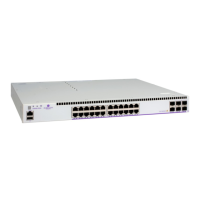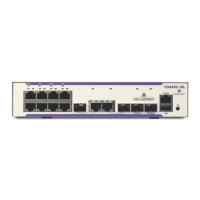Virtual Private LAN Services
7210 SAS M Services Guide Page 263
VPLS and Spanning Tree Protocol
Alcatel-Lucent’s VPLS service provides a bridged or switched Ethernet Layer 2 network.
Equipment connected to SAPs forward Ethernet packets into the VPLS service. The 7210 SAS
participating in the service learns where the customer MAC addresses reside, on ingress SAPs.
Unknown destinations, broadcasts, and multicasts are flooded to all other SAPs in the service. If
SAPs are connected together, either through misconfiguration or for redundancy purposes, loops
can form and flooded packets can keep flowing through the network. Alcatel-Lucent’s
implementation of the Spanning Tree Protocol (STP) is designed to remove these loops from the
VPLS topology. This is done by putting one or several SAPs in the discarding state.
Alcatel-Lucent’s implementation of the Spanning Tree Protocol (STP) incorporates some
modifications to make the operational characteristics of VPLS more effective.
The STP instance parameters allow the balancing between resiliency and speed of convergence
extremes. Modifying particular parameters can affect the behavior. For information on command
usage, descriptions, and CLI syntax, refer to Configuring a VPLS Service with CLI on page 305.
Spanning Tree Operating Modes
Per VPLS instance, a preferred STP variant can be configured. The STP variants supported are:
•
rstp — Rapid Spanning Tree Protocol (RSTP) compliant with IEEE 802.1D-2004 -
default mode
•
dot1w — Compliant with IEEE 802.1w
•
comp-dot1w — Operation as in RSTP but backwards compatible with IEEE 802.1w
(this mode allows interoperability with some MTU types)
•
mstp — Compliant with the Multiple Spanning Tree Protocol specified in IEEE 802.1Q-
REV/D5.0-09/2005. This mode of operation is only supported in an mVPLS.
While the 7210 SAS initially uses the mode configured for the VPLS, it will dynamically fall back
(on a per-SAP basis) to STP (IEEE 802.1D-1998) based on the detection of a BPDU of a different
format. A trap or log entry is generated for every change in spanning tree variant.
Some older 802.1W compliant RSTP implementations may have problems with some of the
features added in the 802.1D-2004 standard. Interworking with these older systems is improved
with the comp-dot1w mode. The differences between the RSTP mode and the comp-dot1w mode
are:
• The RSTP mode implements the improved convergence over shared media feature, for
example, RSTP will transition from discarding to forwarding in 4 seconds when operating
over shared media. The comp-dot1w mode does not implement this 802.1D-2004
